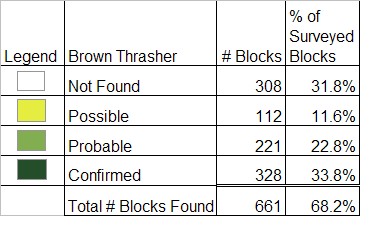Breeding Bird Atlases (BBA)
Find a Bird - BBA1
Breeding Bird Atlas 1 Species Accounts
Brown Thrasher
Toxostoma rufum
Egg Dates
May 9 to June 24
Number of Broods
one, possible two; may re-lay if first attempt fails.

The well-known and distinctive Brown Thrasher is widespread in Massachusetts but is more common in the eastern part of the state and in the southern Connecticut River valley than in the central and western sections. As a rule, the thrasher is shy and retiring, a bird of the countryside rather than the shrubbery about the lawn or garden. Brown Thrashers breed in areas of dry secondary growth, such as is found along high-tension-line clearings and overgrown pastures; in dry forests bordering fields; and in coastal thickets. They are absent in deep forests and in the higher mountains. Thrashers are most abundant in the oak-pine habitat of southeastern portions of the state.
The first spring migrants begin arriving in our area during the latter part of April and early May. Males may not sing for several days after settling into an area but become conspicuous once they begin to vocalize from the top of a shrub or tall deciduous tree that has yet to leaf out. They assume a characteristic singing pose with the tail directed downward. At planting time, a thrasher sitting on some treetop near a busy farmer sings, so the country people say, Drop it, drop it, cover it, cover it, I’ll pull it up, I’ll pull it up, and so it has been called the “Planting Bird.” Singing occurs from late April to early July, but the frequency diminishes as nesting progresses. The song is bold and emphatic, and the phrases are abrupt and often distinctly double phrased. Although it may mimic the songs and calls of other birds, the thrasher is much less versatile in this regard than the familiar mockingbird. The common calls are several whistled notes and a loud smack.
During courtship, the male follows the female about, singing softly. The bulky nest is usually built in a bush or low tree, often on the ground, and is composed largely of twigs and roots and lined with fine rootlets. Bent reported that, in southeastern Massachusetts, half of the nests that he found were on the ground under bushes, trees, or thickets and half were in bushes, small trees, and brush heaps. The highest was located at 4 feet in an Arbor Vitae. In the vicinity of Boston, 10 of 23 nests were built on the ground (ACB). Nine recent state nests were recorded as follows: crabapple (1 nest), Multiflora Rose (2 nests), Red Cedar (1 nest), Bog Rosemary (1 nest), Pasture-juniper (1 nest), honeysuckle (2 nests), White Pine sapling (1 nest). Heights ranged from 2 to 6 feet, with an average of 3.6 feet (CNR).
Incubation of the three to five eggs is shared by both adults for 11 to 14 days. Clutch sizes for 7 Massachusetts nests were three eggs (2 nests), four eggs (4 nests), five eggs (1 nest) (CNR, DKW). The young remain in the nest about 12 days—unless frightened out of it earlier by some intruder, at which time they will hide in the underbrush. Nestlings have been reported in the state from May 29 to July 3. Hatching at 1 nest occurred on June 24. Brood sizes for 5 state nests were two young (1 nest), three young (1 nest), four young (3 nests). Fledglings were observed here from June 10 to July 12 (CNR). Thrashers will defend their young fiercely. Second broods have been documented for this species in other areas and may sometimes occur in the Commonwealth as well.
Brown Thrashers pass the greater part of their time on or near the ground, seeking insects, worms, and berries. They run or hop, and when running in great haste they partially spread and even flutter their wings. Their flights usually are short, low, and not very rapid. Thrashers like to dust themselves, and they are fond of bathing. There is a gradual accumulation of resident Brown Thrashers during the spring and a gradual departure during the fall. In August, they molt and become conspicuous in small groups before gradually slipping away to the south through-out October. A few winter in Massa-chusetts, and, although they are scattered widely through the interior, the preponderance of wintering birds is along the milder coast. Most of our breeding thrashers winter in the southeastern United States.
Many observers have commented on the decrease in Brown Thrashers, especially in eastern portions of the state. This is most likely due in part to extensive development coupled with the continued reforestation of the second-growth areas they prefer.
Map Legend and Data Summary
Atlas 1 data collected from 1975-1979


Note: uncommon in brushy second growth and forest edges
Ruth P. Emery



